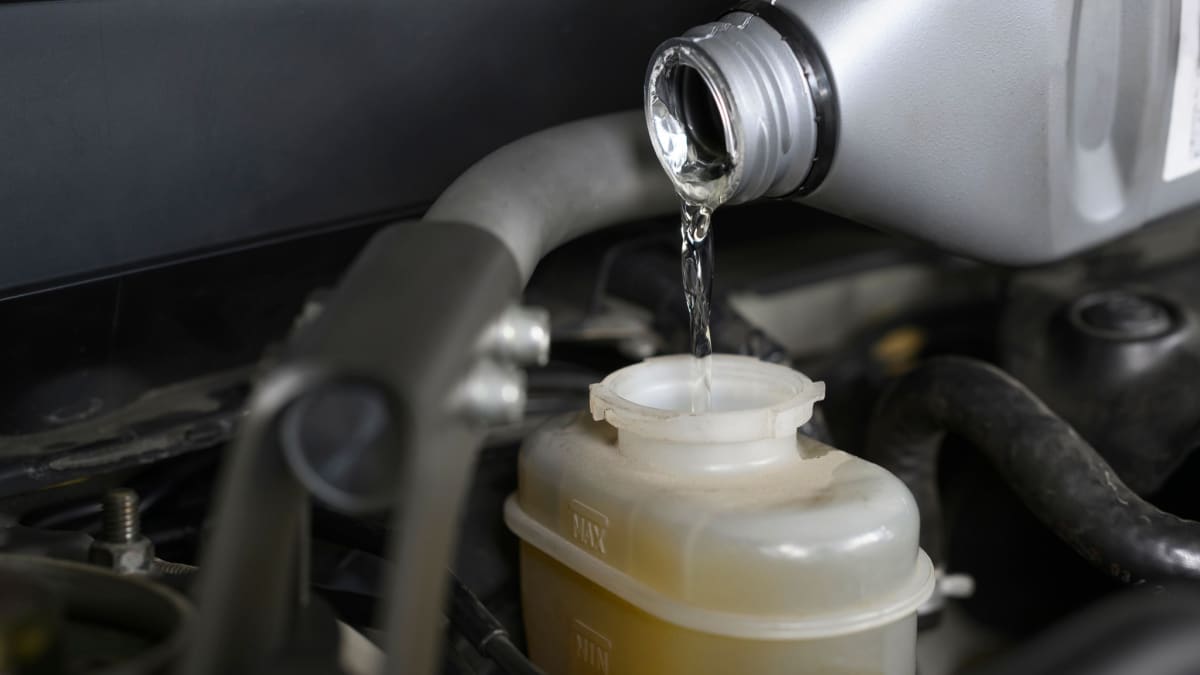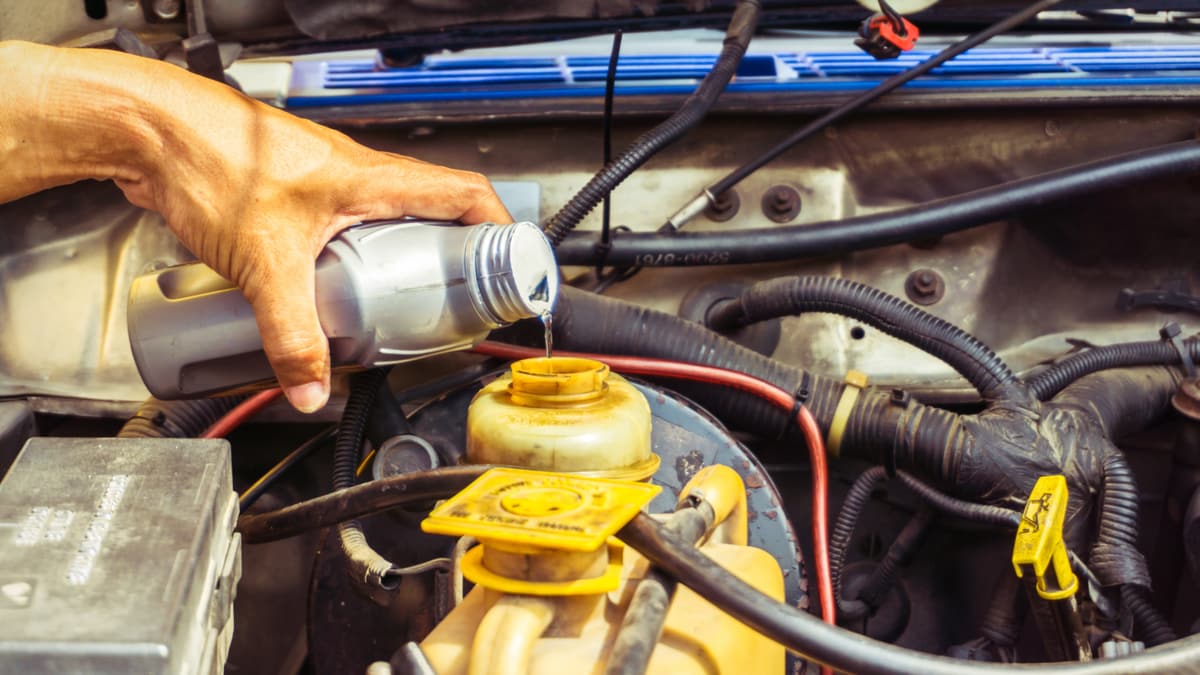Your car uses many different types of fluids, each with its own purpose. It might seem tempting to use some of these different fluids interchangeably, but is this a wise idea?
In this guide, I describe both power steering fluid and brake fluid to you, while also showing you the drastic differences between the two. I help you find legitimate power steering fluid alternatives and show you what to do if you’ve accidentally used brake fluid in place of power steering fluid.
Can You Use Brake Fluid As Power Steering Fluid?
No. Brake fluid is very different from power steering fluid, and these two fluids shouldn’t be used interchangeably. If you put brake fluid into the power steering system or vice versa, you can cause irreparable damage to the vehicle. These are only meant to be used in their respective systems.
If you added brake fluid to the power steering fluid reservoir or vice versa, you will want to drain the system and refill it with the right fluid to prevent damage or accidents.
What is Power Steering Fluid?
Power steering fluid is petroleum based. While it works as a lubricant between the metal components, it’s also needed to provide pressure transfer.
This fluid helps apply the necessary pressure to the hydraulic piston. With this fluid, the wheels turn with ease as you maneuver the steering wheel.
What is a Brake Fluid?
Most brake fluid is glycol based. While it also provides some lubrication, it also absorbs moisture to prevent corrosion from occurring.
This fluid helps to apply pressure from the brake pads to the rotors. With this action, the car can stop when you push down the brake pedal.
RELATED: DOT 3 vs. DOT 4 Brake Fluid Differences (Can You Mix Them?)
Power Steering Fluid vs. Brake Fluid
1. Composition
Power steering fluid is petroleum based. While gasoline is also petroleum-based, the two liquids do not have the same composition.
On the other hand, brake fluid is usually glycol based. You may also have heard of this ingredient based on what’s included with some antifreeze mixtures.
2. Heat Control
Power steering fluid provides a pressure transfer medium and is also a lubricant for metal-to-metal components. This fluid absorbs heat, yet remains at the same viscosity for reliable performance.
Brake fluid isn’t needed for lubricating parts the same way, even though it does provide some benefit. It mainly absorbs moisture to prevent corrosion from occurring. It also dissipates the heat while remaining at the same viscosity. Because of the high boiling point, the brakes won’t fail on you or get spongy.
3. System Compatibility
Power steering fluid is needed for the dynamic steering system in your vehicle. If it is used in the brake system, it can damage the rubber parts.
Brake fluid is basically a non-lubricating fluid. If used in the power steering system, vital parts won’t get the protection they need, and damage will occur.
Power Steering Fluid Alternatives
If you are out of power steering fluid and are in a pinch, you might be able to use some automatic transmission fluid. These two are often similar in composition, and some manufacturers permit them to be used interchangeably. However, you should always check the owner’s manual before you swap any fluid for another.
Vehicles don’t use as much power steering fluid as transmission fluid. For this reason alone, manufacturers put the two into different bottle sizes with differing packaging. With unique packaging, the manufacturer can advertise the fluid for a different price.
RELATED: 3 Different Power Steering Fluid Types (& How to Change)
What to do if Brake Fluid was Used for Power Steering Fluid
If you put brake fluid into the power steering reservoir by accident, you must take quick action. You can prevent major damage by following these steps.
- Do not turn on the vehicle or drive it. It’s important to prevent the brake fluid from circulating through the power steering system. You can prevent damage from happening. Without turning on the vehicle, all of the brake fluid that was poured in will sit in the reservoir.
- Open the reservoir to the power steering fluid.
- With a baster, start removing the fluid from the container. Make sure you place it in an appropriate container.
- Jack up the vehicle in the front. Secure it on jack stands.
- Move the steering wheel from side to side. You should see more fluid come into the reservoir.
- With your turkey baster, continue removing the fluid that appears.
- (Optional) To be on the safe side, you can also empty the whole system. Disconnect the system’s low-pressure line. Drain the fluid into an appropriate container.
- Continue turning the wheel so more fluid can be flushed out.
- Pour in some new power steering fluid and drain it back out as well. This step helps to flush out anything remaining in the system. You should repeat this step several times, just to be sure.
- Put the system back together.
- Lower the vehicle gently back to the ground.
- Fill up the power steering system with the appropriate fluid type.
If you don’t want to work on your own car or you are nervous about draining this system properly, you should get help from a professional mechanic. However, you can’t drive it to the shop. Instead, you would need to have the car towed. A mechanic can provide a professional flush, ensuring there’s no remaining fluid in the system.
Damage Caused by Brake Fluid in Power Steering System
If the brake fluid is able to circulate through the system, you will have a much harder time getting it out. Not only will this fluid smell bad, but you will notice something different with the steering system.
At first, it can cause the rubber seals to swell, leading to a leak. If left unchecked, the long-term effects can become pricey to repair. For example, if you need to replace the power steering pump, you could spend anywhere from $250 to $1,000, depending on the type of vehicle you drive.
How to Check Power Steering Fluid
1. Locate Reservoir
The first step to checking the power steering fluid is finding the appropriate reservoir. After all, your car probably has several containers filled with fluid under the hood.
You can look in your owner’s manual to find its location, as each model is different. It should be a small container that’s clear and it usually contains a black cap on the top.
2. Examine Dipstick
If the vehicle has a dipstick system, there will be marks on it to look at. It should remind you of an oil dipstick. Remove the cap for the dipstick and wipe it clean with a shop towel.
If there’s no dipstick, you will examine the tank by the marks on the side. There should be a MAX and MIN line that the fluid should rest between.
3. Double-Check
Put the cap back on so the dipstick rests back in the fluid. You want to double-check it to see what level the fluid is at.
Most dipsticks contain marks that either say MAX and MIN or Full Hot and Full Cold. Either way, you want to ensure the level is located at the appropriate spot on the dipstick.
4. Fill, if Needed
If the power steering system is low, you need to top it off. Fill up the reservoir until it reaches the proper level.
If the fluid looks contaminated, you might want to perform a power steering flush instead. Most manufacturers recommend performing this maintenance task every 40,000 to 80,000 miles.
Can you mix brake fluid and power steering fluid?
No. You should not mix brake fluid and power steering fluid. Mixing or using these in the wrong system can cause serious damage to your car or even cause accidents. While both fluids are designed to lubricate and protect your car’s components, they serve different purposes and mixing the two can cause problems.
Can you use transmission fluid instead of power steering fluid?
It depends, in many older vehicles, the transmission fluid and power steering fluid were the same. However, in modern cars you will often find that these two fluids differ from each other. Check your owner’s manual and use only a compatible fluid for your vehicle.
Can you use brake fluid for anything else?
Brake fluid is a type of hydraulic fluid that is used in brake and clutch systems. While brake fluid is not something you can just use for anything else, it does have a few other uses beyond braking. Sometimes brake fluid can be used to clean metal parts, and brake fluid can also be used as a hydraulic fluid for other applications, such as hydraulic jacks and lifting equipment.
Can you use transmission fluid as brake fluid?
No. Transmission fluid should not be used in place of brake fluid. Using transmission fluid in your brakes can cause damage to brake components and may even result in loss of brake power, which can result in a serious accident or even death.
RELATED: Brake Fluid Flush – Why You Need It & What It Costs
Categories: Brakes, Maintenance













